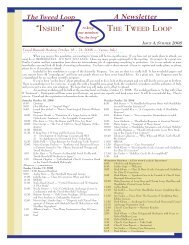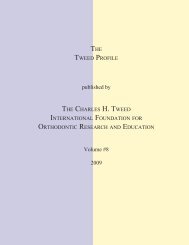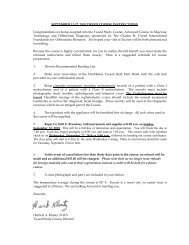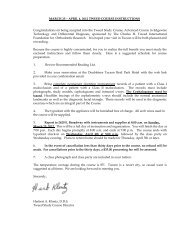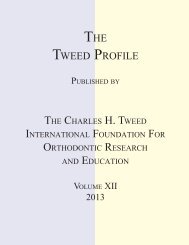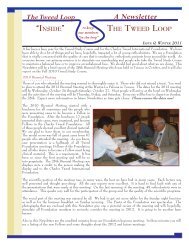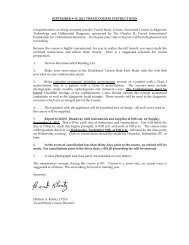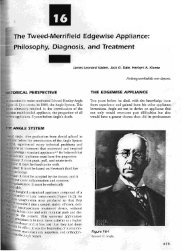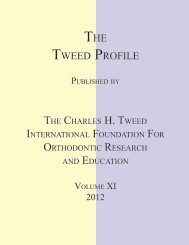© 2006 - The Charles H. Tweed International Foundation
© 2006 - The Charles H. Tweed International Foundation
© 2006 - The Charles H. Tweed International Foundation
Create successful ePaper yourself
Turn your PDF publications into a flip-book with our unique Google optimized e-Paper software.
Microimplant Anchorage (MIA) in OrthodonticsIl-Bong Kim D.D.S., Ph.D.<strong>The</strong> Korean Orthodontic Research Institute Inc.Jae-Hyun, Sung DDS,MSD,Ph.DProfessor Emeritus, Kyungpook National UniversityI. A Brief History of Development of Orthodontic AnchorageLooking back over the last 40 years of my career as an orthodontist has been a constant process of trying to identifywhich technique is the most effective for a certain type of malocclusion correction. Drifting from one technique toanother in pursuit of a better technique, I came to understand how the huge orthodontic community has progressed. Irealized that a careful observation of its evolution would offer answers to fundamental questions. <strong>The</strong>refore, I’d like topresent a summarized development of anchorage concepts. Orthodontics owes much of what it is today to E. H. Angle.Since the 1900s, generational changes seem to have taken place every 30-40 years. <strong>The</strong> development of anchorageconcepts can be divided into 4 distinct periods.I) <strong>The</strong> first generation (1900 – 1930)II) <strong>The</strong> second generation (1930 – 1970)III) <strong>The</strong> third generation (1970 – 2000)IV) <strong>The</strong> fourth generation (2000 – )<strong>The</strong> first generation (1900 – 1930)In the late 1800s, Dr. Edward Hartley Angle became interested in orthodontics and proposed that it should be treatedas a separate science independent of dentistry. In 1900, he established “<strong>The</strong> Angle School of Orthodontics” whereorthodontics was taught as an independent field of dentistry for the first time. He advocated not extracting, butaccommodating the full complement of teeth during orthodontic treatment. <strong>The</strong>re was no concepts of anchorage.2) <strong>The</strong> second generation (1930 – 1970)In 1930, with the death of Dr. Angle and the introduction of the cephalometric headplate by Dr. Broadbent,orthodontics took on a new aspect. Dr. <strong>Tweed</strong> established the diagnostic facial triangle. People agreed that extractionwas often necessary. <strong>Tweed</strong>’s reasons for extraction seem to have prevailed. When extraction is done, one is inevitablyreminded of Newton’s third law “For every action, there is an equal and opposite reaction.”In orthodontics this means that when retracting front teeth, one will be faced with the problem of having to minimize thetendency of the posterior teeth to moveforward. <strong>The</strong> minimization of such forceis called “Anchorage”. <strong>The</strong> strengtheningof anchorage is referred to as “anchoragepreparation”. Dr. <strong>Tweed</strong> introducedenmasseanchorage preparation with secondorder bends.3) <strong>The</strong> Third generation (1970 – 2000)Dr. Levern Merrifield refined <strong>Tweed</strong>’s enmassanchorage preparation by using J-hookhigh pull headgear and by proposingsequential anchorage preparation.4) <strong>The</strong> fourth generation (2000 – )<strong>The</strong> problem that is sometimes encounteredwith the <strong>Tweed</strong> Merrifield technique isrelated to J-hook high pull headgear wear.Since this procedure requires co-operationfrom patients, this technique cannot be fullyeffective when patients do not follow through.Edward H. Angle(1855~1930)First Generation (1900~1930)“Old Glory” which Angle used toexemplify nomal occlusion35



